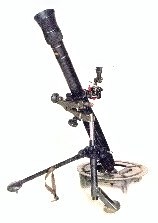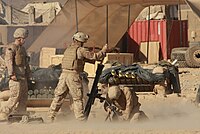M252 mortar
| M252 mortar | |
|---|---|
 | |
| Type | Mortar |
| Place of origin | |
| Service history | |
| In service | 1987–present (United States)[1] |
| Used by | Operators by Country |
| Wars | Gulf War War in Afghanistan Iraq war |
| Specifications | |
| Mass | 41.3 kilograms (91 lb) |
| Length | 50 in (127 cm) |
| Barrel length | 1.27 metres (4 ft 2 in) |
| Crew | 5 |
| Caliber | 81 millimetres (3.2 in) |
| Elevation | 45°–85.2° |
| Traverse | 5.6° |
| Rate of fire | 8–16 rpm sustained 20–30 rpm in exceptional circumstances and for short periods |
| Effective firing range | HE: 91–5,935 m (99–6,490.6 yd)[1] |
| Feed system | muzzle-loaded |
The M252 81 mm medium weight mortar is a British designed smooth bore, muzzle-loading, high-angle-of-fire weapon used for long-range indirect fire support to light infantry, air assault, and airborne units across the entire front of a battalion zone of influence. In the U.S. Army and U.S. Marine Corps, it is normally deployed in the mortar platoon of an infantry battalion.
Design
The M252 system weighs 91 lb (41 kg) completely assembled and is composed of the M253 Cannon (35 lb, 16 kg), M177 Mount (27 lb, 12 kg), M3A1 Baseplate (29 lb, 13 kg), and the M64A1 Sight Unit (2.5 lb, 1.1 kg).[1] The mount consists of a base plate and a bipod, which is provided with screw type elevating and traversing mechanisms to elevate/traverse the mortar. The M64A1 sight unit (also used on the M224) is attached to the bipod mount. The M252 is a gravity-fired smoothbore system. Attached to the muzzle of the weapon is the Blast Attenuation Device (BAD), used to reduce the blast effects on the mortar crew. To increase cooling efficiency, the breech end is finned; though first-hand accounts attest that the level of cooling is negligible. The cannon also has a crew-removable breech plug and firing pin.
History
The M252 is an adaptation of the British 81mm L16A2 mortar developed in the 1950s. It entered service with the U.S. Army and replaced the previous 81 mm M29 mortar in 1987. It was adopted due to the extended range (from 4,500 meters to 5,650 meters) and enhanced lethality. In the U.S. it is produced by Watervliet Arsenal.
A much lighter version, the M252A1, was fielded for the first time in late 2014. By reducing the number of parts and using lightweight materials, the total weight was reduced by 20.8 pounds to 79 pounds. In the next two years, all U.S. Army M252s will be replaced by the M252A1. As part of the same program, a lightweight version of the M224 60mm mortar was also developed.[2][3] The Marines developed an improved M252A2 version that weighs 10 pounds less than the original and incorporates a 4x magnification sight with a new cooling system.[4]
Operation
Crew
The M252 uses a crew of five enlisted personnel to operate: the squad leader, the gunner, the assistant gunner, the first ammunition bearer, and the second ammunition bearer.
- The squad leader stands directly behind the mortar where he can command and control his squad. In addition to having general oversight of all squad activities, he also supervises the emplacement, laying, and firing of the weapon.
- The gunner stands to the left of the mortar where he can manipulate the sight, traversing handwheel, and elevating handwheel. He places firing data on the sight and lays the mortar for deflection and elevation. He makes large deflection shifts by shifting the bipod assembly and keeps the bubbles level during firing.
- The assistant gunner stands to the right of the mortar, facing the barrel and ready to load. In addition to loading, he swabs the bore after 10 rounds have been fired or after each fire mission. The assistant gunner is the person who actually fires the weapon.
- The first ammunition bearer stands to the right rear of the mortar. He has the duty of preparing the ammunition (charge settings, fuzes, etc...) and passing it to the assistant gunner.
- The second ammunition bearer stands to the right rear of the mortar behind the ammunition bearer. He maintains and keeps a record of the ammunition in addition to the data corresponding to each fire mission. His twofold records include a written table of firing data, type, and number of rounds fired, and the safety pins pulled from each round to provide physical evidence to the accuracy of the table. In addition he provides local security for the mortar position.
-
M252 mortar and crew in Afghanistan, 2009.
-
M252 mortar crew and ammunition in Afghanistan, 2008.
Types of rounds

While the M252 does fire a weapon specific series of ammunition, it can also fire rounds from the M29 Mortar (only at charge 3 or below though). The M252 Mortar can fire the following principal classifications of training and service ammunition:[5]
- High explosive (HE): Designations M821, M821A1, M889, M889A1, M372-series, and M362. Used against personnel and light materiel targets.
- Smoke Cartridge: Designations M819 and M375-series. Used as a screening, signaling, or marking munition.[6]
- Illumination (ILLUM): Designations M853A1 and M301-series. Used in night missions requiring illumination for assistance in observation.
- Non-Lethal Indirect Fire Munition: Developmental round based on the M853A1 that disperses flash bang submunitions to temporarily daze people.[7][8]
- Training practice (TP): Designations M880, M879, M68 and sabot. Used for training in limited areas.
- Infrared Illumination (IR): Produces illumination which is only visible through the use of night vision devices.
Fuzes
The M224 rounds have two fuze types: the Multioption Fuze (M734) and the Point-Detonating Fuze (M935). The M734 is used for the M720 HE round and can be set to function as proximity burst, near-surface burst, impact burst, or delay burst.
Method of propulsion
The range of a mortar is controlled by what are referred to as "charges." Charges are semi-circular nitrocellulose donuts that resemble a puffy letter "C." Ammunition for the M252 mortar come with four charges. Longer range shots require more propellant than can be easily stored in the tail of the round, hence the necessity of the charges to be placed on the round. Once a target is ranged, the correct charge is placed on the round by removing the charges from the projectile. Once the charges are verified by the section leader, the round is dropped down the muzzle of the tube. The round, pulled by gravity, accelerates down the smooth bore of the mortar until the primer (in the base of the tail boom of the round) strikes the firing pin located in the bottom of the mortar tube. The primer detonates igniting the charge in the tail fin which in turn ignites any of the C-charges on the round. The expanding gas created by the burning charges push against the obturator band on the round, sealing the gasses and gives the round forward momentum. The round is accelerated by the gasses until it leaves the end of the tube.
Operators

Current operators
See also
- Artillery
- Military technology and equipment
- List of artillery
- List of crew served weapons of the US Armed Forces
- L16 81mm Mortar (original designation)
References
- ^ a b c [1]
- ^ http://www.ground-combat-technology.com/gct-home/322-gct-2011-volume-2-issue-2-mayjune/4270-mortars-and-ammo.html
- ^ Army Delivers Lighter 81mm Mortars - Kitup.Military.com, 15 December 2014
- ^ Marines get new mortar in Iraq to protect base from IS - Militarytimes.com, 7 December 2015
- ^ "81mm Mortar Ammunition And Fuzes" Gary's U.S. Infantry Weapons Reference Guide, 10 May 2006. Retrieved: 10 June 2012.
- ^ M819 81mm Smoke Cartridge http://www.globalsecurity.org/military/systems/munitions/m819.htm
- ^ Marines, soldiers could soon carry 'flash bang' mortars - MarineCorpstimes.com, 6 December 2014
- ^ Need to know, 2015: What's new in gear and uniforms - MarineCorpstimes.com, 24 December 2014


